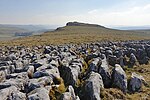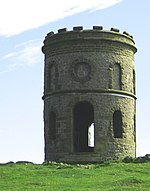Harpur Hill Quarry

Harpur Hill Quarry is a disused limestone quarry on Harpur Hill, Derbyshire, England. Limestone was extracted there from 1835 to 1952 for lime burning at lime kilns to produce quicklime. The quarry was used by the Royal Air Force as a chemical weapons storage depot during the Second World War, the largest such depot in the United Kingdom. Afterwards a number of captured German chemical munitions were disposed of at the site by burning, which was only partially successful. The RAF depot closed in 1960 and the site is now vacant. A small part of the abandoned quarry has flooded to become a quarry lake. Its water has a very high pH, that is, it is very alkaline, owing to the presence of caustic chemicals that are leaching from the waste left from the lime burning. The lake water has a vivid blue colour due to the scattering of light by finely dispersed particles of calcium carbonate. Despite signs warning of the health risks the lake became a popular tourist destination and swimming spot. The local High Peak Borough Council dyed the water black in 2013, 2016 and 2020 in an attempt to deter swimmers.
Excerpt from the Wikipedia article Harpur Hill Quarry (License: CC BY-SA 3.0, Authors, Images).Harpur Hill Quarry
Solomans Court, High Peak
Geographical coordinates (GPS) Address Nearby Places Show on map
Geographical coordinates (GPS)
| Latitude | Longitude |
|---|---|
| N 53.2336 ° | E -1.9043 ° |
Address
Solomans Court
Solomans Court
SK17 9HP High Peak
England, United Kingdom
Open on Google Maps








